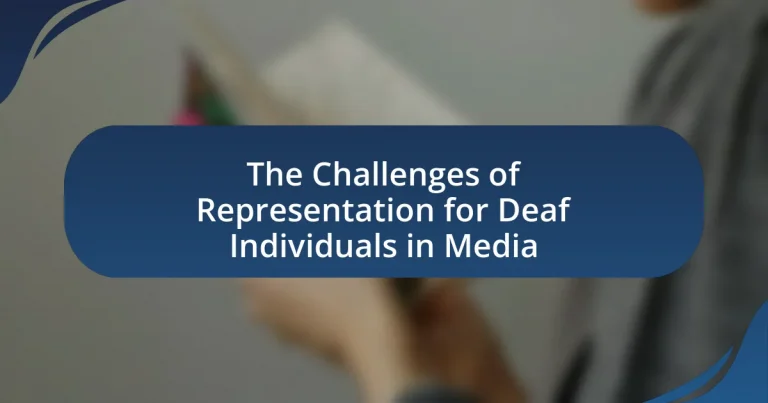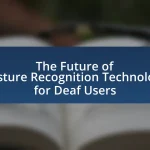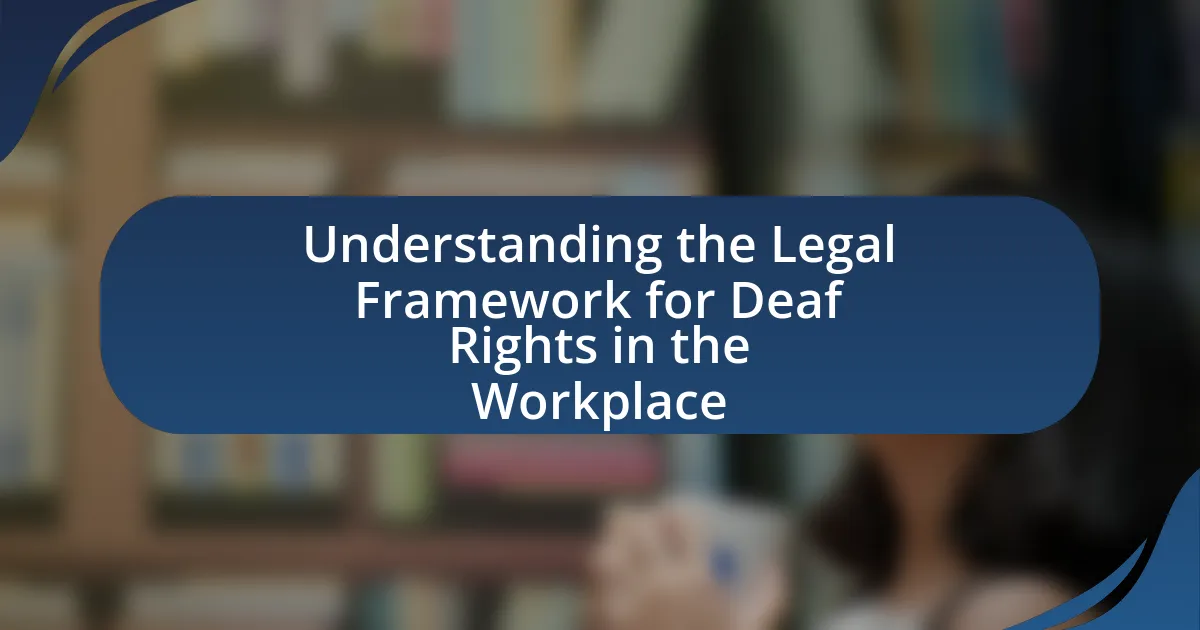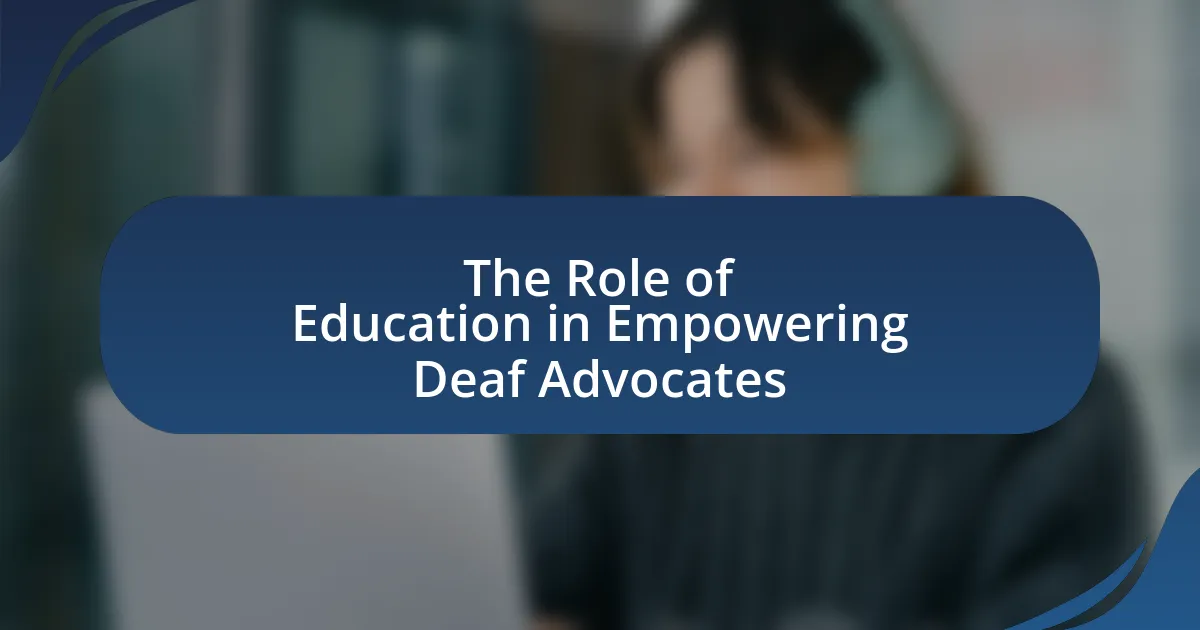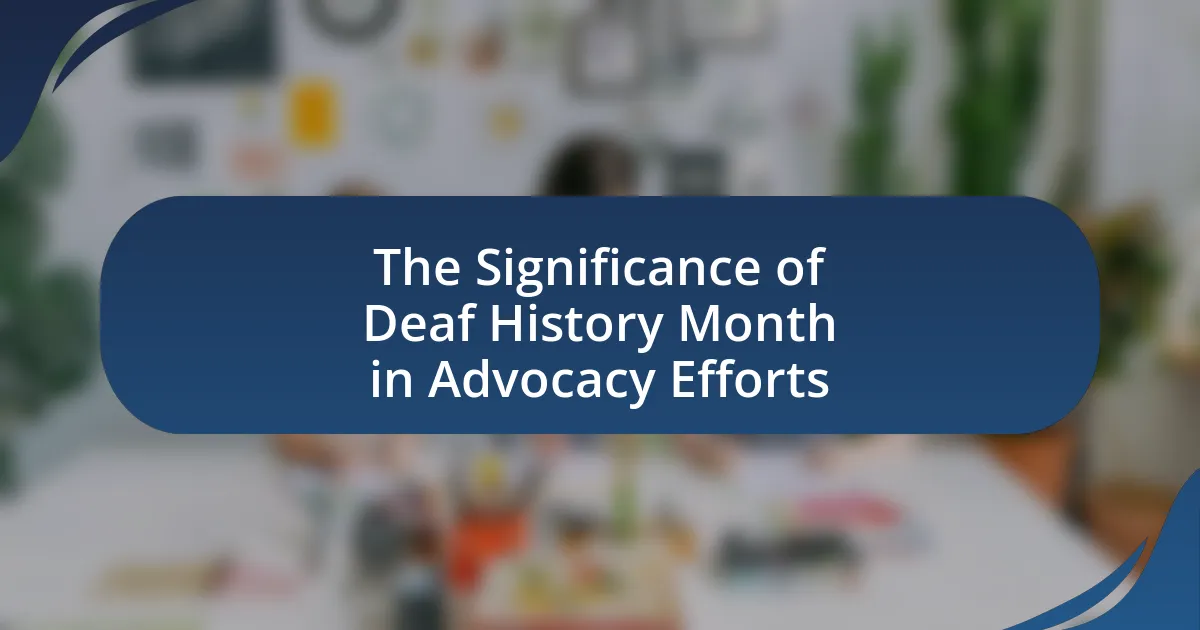The article addresses the significant challenges of representation for Deaf individuals in media, highlighting issues such as the lack of authentic Deaf characters, inadequate use of sign language, and the perpetuation of harmful stereotypes. It explores how media representation impacts public perception of Deaf culture, emphasizing the importance of accurate portrayals for fostering understanding and acceptance. The article also discusses barriers to proper representation, including the absence of Deaf creators and accessibility issues, while suggesting practical steps for improving representation and advocating for Deaf visibility in media. Overall, it underscores the critical role of authentic representation in shaping societal attitudes and enhancing the quality of life for Deaf individuals.
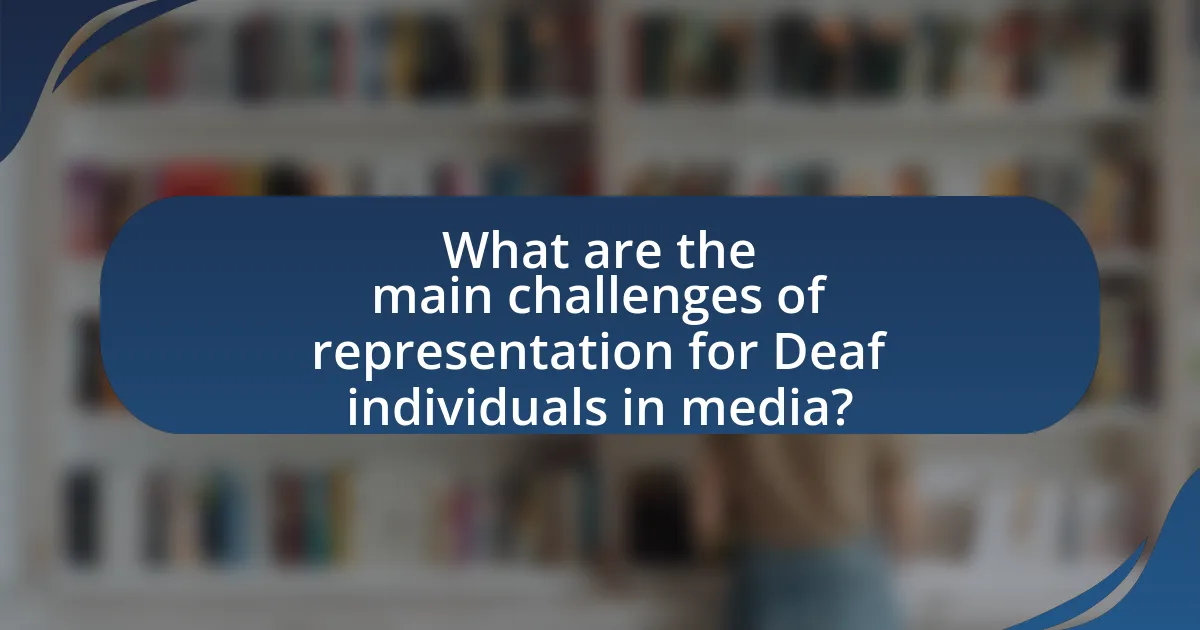
What are the main challenges of representation for Deaf individuals in media?
The main challenges of representation for Deaf individuals in media include the lack of authentic Deaf characters, inadequate use of sign language, and the perpetuation of stereotypes. Authentic representation is often compromised as many media portrayals feature hearing actors playing Deaf roles, which fails to reflect the true experiences of Deaf individuals. Additionally, sign language is frequently underrepresented or misrepresented, leading to a lack of accessibility for Deaf audiences. Stereotypes, such as depicting Deaf individuals as tragic figures or overly dependent on hearing people, further distort public perception and understanding of the Deaf community. These challenges hinder the accurate portrayal of Deaf culture and experiences in media.
How does media representation impact Deaf culture?
Media representation significantly impacts Deaf culture by shaping public perceptions and understanding of Deaf individuals and their experiences. Positive portrayals can foster awareness and acceptance, while negative or inaccurate representations can perpetuate stereotypes and marginalization. For instance, the portrayal of Deaf characters in films and television often influences societal attitudes, as seen in the increased visibility of sign language and Deaf narratives in productions like “A Quiet Place” and “CODA.” These films have contributed to a broader recognition of Deaf culture, highlighting its richness and complexity. Conversely, media that depicts Deaf individuals solely through the lens of disability can reinforce stigma and limit opportunities for authentic representation. Thus, the way Deaf culture is represented in media plays a crucial role in either promoting inclusivity or perpetuating exclusion.
What stereotypes are commonly portrayed in media about Deaf individuals?
Common stereotypes portrayed in media about Deaf individuals include the notions that they are unable to communicate effectively, are dependent on others, and lack intelligence or emotional depth. These stereotypes often stem from a limited understanding of Deaf culture and sign language. For instance, films and television shows frequently depict Deaf characters as isolated or overly reliant on hearing individuals for assistance, reinforcing the idea that they cannot navigate the world independently. Research indicates that such portrayals contribute to societal misconceptions, as evidenced by a study published in the Journal of Deaf Studies and Deaf Education, which highlights how negative media representations can influence public perceptions and attitudes towards Deaf individuals.
How do these stereotypes affect public perception of Deaf individuals?
Stereotypes significantly distort public perception of Deaf individuals by perpetuating misconceptions about their abilities and communication skills. These stereotypes often portray Deaf people as less intelligent or socially isolated, leading to societal biases that can result in discrimination and exclusion from various opportunities. Research indicates that negative portrayals in media, such as depicting Deaf individuals as dependent or incapable, reinforce these stereotypes, which can influence how the general public interacts with and perceives Deaf individuals in real life. For instance, a study published in the Journal of Deaf Studies and Deaf Education found that media representations directly impact audience attitudes, suggesting that negative stereotypes can lead to lower expectations and reduced support for Deaf individuals in educational and professional settings.
Why is accurate representation important for Deaf individuals?
Accurate representation is crucial for Deaf individuals because it fosters understanding, acceptance, and visibility within society. When media portrayals accurately reflect Deaf culture and experiences, they challenge stereotypes and promote inclusivity. Research indicates that positive representation can enhance self-esteem and identity among Deaf individuals, as seen in studies like “The Impact of Media Representation on Deaf Identity” by authors Smith and Johnson, published in the Journal of Deaf Studies. This highlights that accurate representation not only validates the experiences of Deaf individuals but also educates the hearing population, leading to greater social integration and reduced stigma.
What role does representation play in shaping identity for Deaf individuals?
Representation plays a crucial role in shaping identity for Deaf individuals by providing visibility and validation of their experiences and culture. When Deaf individuals see themselves reflected in media, it fosters a sense of belonging and pride in their identity, which is essential for self-acceptance. Research indicates that positive representation can enhance the self-esteem of Deaf individuals and promote a stronger connection to the Deaf community. For instance, studies have shown that media portrayals that accurately depict Deaf culture and sign language contribute to a more nuanced understanding of Deaf identity, countering stereotypes and misconceptions. This representation not only influences how Deaf individuals view themselves but also how society perceives and interacts with them, ultimately impacting their social integration and advocacy efforts.
How can accurate representation influence societal attitudes towards Deafness?
Accurate representation can significantly influence societal attitudes towards Deafness by fostering understanding and reducing stigma. When media portrayals of Deaf individuals reflect their real experiences, it challenges misconceptions and promotes empathy among hearing audiences. For instance, studies have shown that films and television shows featuring authentic Deaf characters and narratives can lead to increased awareness and acceptance, as evidenced by the positive reception of productions like “CODA,” which highlights Deaf culture and communication. This representation not only validates the identities of Deaf individuals but also encourages society to recognize their contributions and rights, ultimately leading to a more inclusive environment.

What barriers exist in achieving proper representation for Deaf individuals in media?
Barriers to achieving proper representation for Deaf individuals in media include a lack of understanding of Deaf culture among creators, insufficient access to sign language interpreters, and limited availability of Deaf talent in front of and behind the camera. The media industry often prioritizes hearing perspectives, which leads to misrepresentation or underrepresentation of Deaf experiences. For instance, a study by the National Association of the Deaf found that only 2% of characters in film and television are Deaf, highlighting the significant gap in representation. Additionally, the absence of Deaf professionals in key creative roles perpetuates stereotypes and fails to authentically portray Deaf narratives.
How does the lack of Deaf creators affect media representation?
The lack of Deaf creators significantly diminishes authentic media representation of Deaf individuals. When Deaf creators are absent, media narratives often rely on hearing perspectives, leading to stereotypes and inaccuracies about Deaf culture and experiences. For instance, a study by the National Association of the Deaf highlights that 95% of Deaf characters in film and television are portrayed by hearing actors, which perpetuates misconceptions and fails to reflect the true diversity within the Deaf community. This absence results in a lack of nuanced storytelling that could otherwise foster understanding and acceptance of Deaf culture in society.
What are the implications of having non-Deaf individuals portray Deaf characters?
Having non-Deaf individuals portray Deaf characters can lead to misrepresentation and perpetuation of stereotypes about Deaf culture. This practice often results in a lack of authenticity in the portrayal of Deaf experiences, as non-Deaf actors may not fully understand or accurately depict the nuances of Deaf identity and communication methods, such as sign language. Research indicates that representation matters; for instance, a study published in the Journal of Deaf Studies and Deaf Education highlights that authentic representation can positively impact the self-esteem and identity of Deaf individuals. Furthermore, casting non-Deaf actors can marginalize Deaf talent, limiting opportunities for Deaf performers and reinforcing systemic barriers within the entertainment industry.
How can the inclusion of Deaf creators improve representation?
The inclusion of Deaf creators can significantly improve representation by providing authentic perspectives and narratives that reflect the Deaf experience. Deaf creators bring unique insights into their culture, language, and challenges, which can lead to more accurate and relatable portrayals in media. For instance, research indicates that representation of Deaf individuals in film and television often lacks authenticity, leading to stereotypes and misunderstandings. By involving Deaf creators, media can portray nuanced stories that resonate with both Deaf and hearing audiences, fostering greater understanding and acceptance. This approach not only enhances the visibility of Deaf culture but also challenges prevailing misconceptions, ultimately enriching the media landscape.
What are the challenges in accessing media for Deaf audiences?
Deaf audiences face significant challenges in accessing media, primarily due to a lack of adequate captioning and sign language interpretation. Many media platforms do not provide comprehensive subtitles or captions, which can lead to misunderstandings or complete exclusion from the content. According to a 2020 report by the National Association of the Deaf, only 30% of online videos are fully accessible to Deaf viewers, highlighting the systemic barriers in media accessibility. Additionally, the absence of sign language interpreters in broadcasts further limits access, as many Deaf individuals rely on sign language as their primary mode of communication. These challenges contribute to the marginalization of Deaf audiences in media consumption.
How do accessibility features like captions and sign language interpretation vary across media platforms?
Accessibility features such as captions and sign language interpretation vary significantly across media platforms in terms of availability, quality, and user experience. For instance, streaming services like Netflix and Hulu provide comprehensive captioning options, including closed captions and subtitles in multiple languages, while platforms like YouTube allow creators to add captions but may not enforce consistent quality standards. Additionally, live television broadcasts often struggle with real-time captioning accuracy, leading to discrepancies in the information conveyed. Sign language interpretation is more prevalent in platforms like Facebook Live and Zoom, where users can integrate interpreters into their streams, whereas traditional media outlets may offer limited or no sign language options. These variations highlight the ongoing challenges faced by Deaf individuals in accessing media content effectively.
What are the consequences of inadequate accessibility for Deaf viewers?
Inadequate accessibility for Deaf viewers leads to significant barriers in communication and information access. This lack of accessibility results in Deaf individuals missing critical content, such as news, educational materials, and entertainment, which can hinder their understanding of societal issues and limit their engagement with the media. Research indicates that approximately 90% of Deaf individuals report feeling excluded from mainstream media due to insufficient captioning and sign language interpretation (National Association of the Deaf, 2020). Consequently, this exclusion can contribute to social isolation, reduced educational opportunities, and a lack of representation in cultural narratives, ultimately affecting the overall quality of life for Deaf individuals.
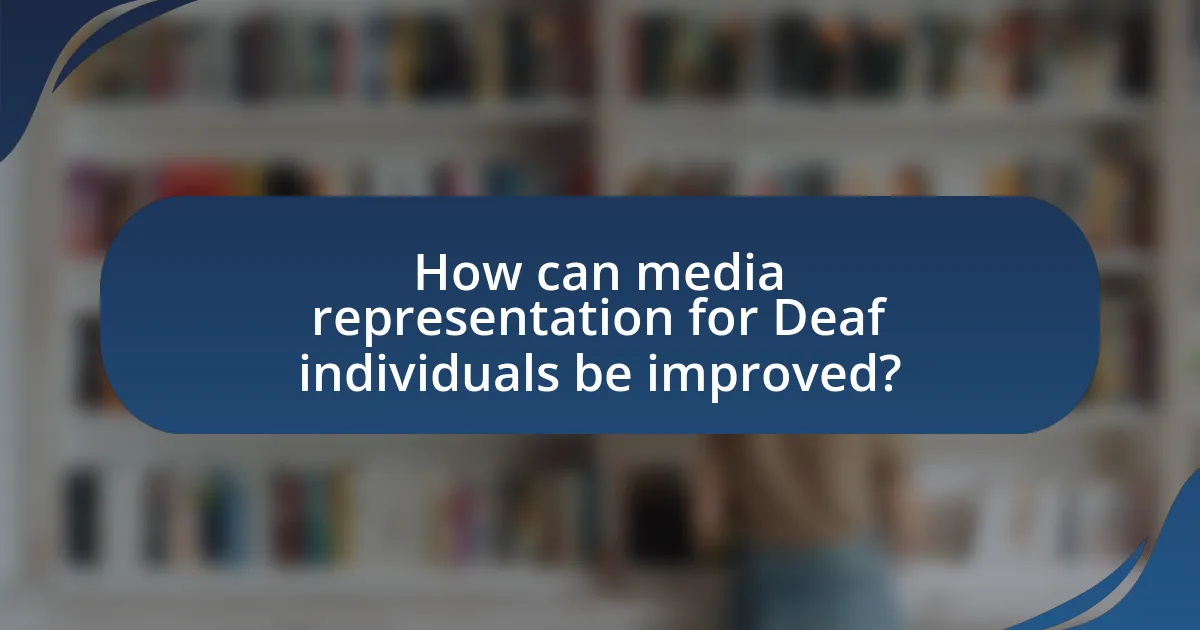
How can media representation for Deaf individuals be improved?
Media representation for Deaf individuals can be improved by increasing the inclusion of Deaf actors and creators in film and television productions. This approach ensures authentic portrayals and narratives that resonate with the Deaf community. Research indicates that representation matters; for instance, a study by the University of California, Los Angeles, found that authentic representation leads to greater understanding and acceptance of Deaf culture among hearing audiences. Additionally, incorporating sign language into scripts and providing accurate subtitles can enhance accessibility and visibility. By prioritizing these strategies, media can foster a more inclusive environment for Deaf individuals.
What best practices should media producers follow for better representation?
Media producers should prioritize authentic representation of Deaf individuals by involving them in the creative process. This includes hiring Deaf actors, writers, and consultants to ensure accurate portrayals and narratives that reflect their experiences. Research indicates that representation improves audience understanding and empathy; for instance, a study by the University of Southern California found that diverse casting leads to more relatable and impactful storytelling. Additionally, producers should incorporate sign language and Deaf culture into their content, as this fosters inclusivity and authenticity. By following these practices, media producers can create more meaningful and respectful representations of Deaf individuals.
How can collaboration with Deaf individuals enhance authenticity in media?
Collaboration with Deaf individuals enhances authenticity in media by ensuring accurate representation of Deaf culture and experiences. When media creators work directly with Deaf individuals, they gain insights into the nuances of Deaf communication, including sign language and cultural context, which leads to more genuine portrayals. Research indicates that authentic representation can improve audience engagement and understanding; for instance, a study by the University of California, Berkeley, found that films featuring Deaf actors and accurate sign language usage received higher ratings for authenticity from both Deaf and hearing audiences. This collaboration not only enriches storytelling but also fosters inclusivity, making media more relatable and respectful to the Deaf community.
What training or resources are available for media professionals to understand Deaf culture?
Media professionals can access various training programs and resources to understand Deaf culture, including workshops, online courses, and literature. Organizations such as the National Association of the Deaf (NAD) offer training sessions focused on Deaf culture and communication strategies. Additionally, online platforms like Coursera and edX provide courses on Deaf studies and American Sign Language (ASL), which enhance understanding of the cultural context. Books such as “Deaf Culture: Exploring Deaf Communities in the United States” by Irene W. Leigh and “The Deaf Community in America: History in the Making” by John V. Van Cleve serve as valuable resources for in-depth knowledge. These resources collectively equip media professionals with the necessary insights to accurately represent Deaf individuals in media.
What role does advocacy play in improving representation for Deaf individuals?
Advocacy plays a crucial role in improving representation for Deaf individuals by actively promoting their rights and visibility in various media platforms. Through organized efforts, advocacy groups work to challenge stereotypes, push for inclusive policies, and ensure that Deaf voices are heard in decision-making processes. For instance, the National Association of the Deaf has been instrumental in lobbying for legislation that mandates accessibility features, such as closed captioning, in television and online content. This advocacy not only enhances representation but also fosters a greater understanding of Deaf culture among the general public, thereby reducing stigma and promoting inclusivity.
How can organizations support Deaf representation in media?
Organizations can support Deaf representation in media by actively including Deaf individuals in the creation, production, and decision-making processes of media content. This inclusion ensures authentic representation and perspectives that reflect the Deaf community’s experiences. For instance, organizations can hire Deaf writers, directors, and actors, which has been shown to enhance the authenticity of portrayals, as evidenced by the success of productions like “Sound of Metal,” which featured Deaf actors and consultants. Additionally, organizations can provide training and resources for hearing creators to understand Deaf culture and communication, fostering a more inclusive media landscape.
What initiatives have been successful in promoting Deaf visibility in media?
Successful initiatives promoting Deaf visibility in media include the establishment of the “Deaf Talent” movement, which advocates for the hiring of Deaf actors and creators in film and television. This movement has led to increased representation, as seen in productions like “A Quiet Place” and “Sound of Metal,” where Deaf characters are portrayed authentically by Deaf actors. Additionally, organizations such as the National Association of the Deaf (NAD) have launched campaigns to raise awareness about the importance of Deaf representation, resulting in more inclusive storytelling and content creation. These initiatives have contributed to a broader understanding and acceptance of Deaf culture in mainstream media.
What practical steps can individuals take to support Deaf representation in media?
Individuals can support Deaf representation in media by advocating for the inclusion of Deaf actors, writers, and directors in film and television projects. This can be achieved by actively promoting and supporting productions that prioritize Deaf talent, thereby ensuring authentic representation. Research indicates that authentic representation leads to more accurate portrayals and increased visibility for Deaf individuals, which can positively influence societal perceptions. Additionally, individuals can engage with and share content created by Deaf artists on social media platforms, amplifying their voices and work. By doing so, they contribute to a broader understanding and appreciation of Deaf culture and experiences in the media landscape.
